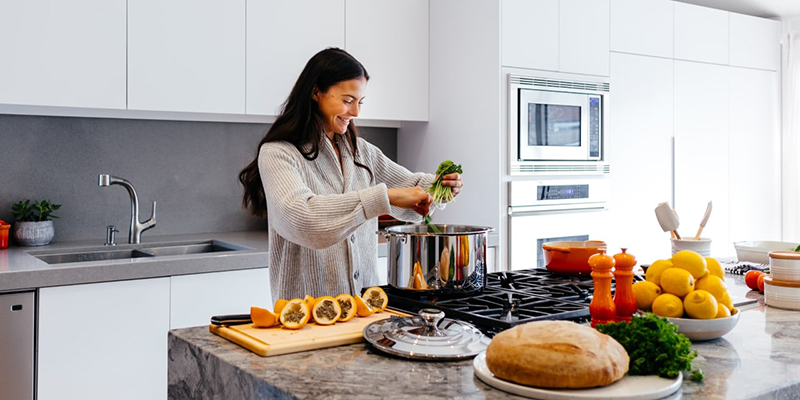The kitchen is the heart of every home—a place of cooking, eating, and a social interaction hub. However, the kitchen is also the place in the house that produces most household waste. With many different cooking resources, the kitchen leaves a significant environmental footprint. Do you know how you can mitigate this? We provide you with some ingenious, practical kitchen hacks that will help reduce waste and conserve resources in your kitchen. Just keep reading!
The kitchen is the heart of every home—a place of cooking, eating, and a social interaction hub. However, the kitchen is also the place in the house that produces most household waste. With many different cooking resources, the kitchen leaves a significant environmental footprint. Do you know how you can mitigate this? We provide you with some ingenious, practical kitchen hacks that will help reduce waste and conserve resources in your kitchen. Just keep reading!

1. Meal Planning
You must have seen the new trend of meal planning on social media. Some recipes and practices help you plan your meals ahead of time. This practice is trendy and a game changer when reducing kitchen waste. How does this work?
You buy only what you need for the week, and a weekly recipe is decided upon, significantly reducing food spoilage.
- With thoughtful meal planning, you could include any leftovers in your next meal, easily avoiding waste.
- You will stick with the items that need to be bought and thus will not engage in impulse buying.
2. Buy Reusable Alternatives
Many kitchens use single-use items mainly for ease of cleaning. However, this adds to the waste that will fill the landfill. So, try incorporating reusable versions of cutlery in the kitchen.
- Buy reusable baking mats instead of the parchment paper.
- Try using cloth napkins rather than paper towels
- Use steel containers instead of plastic ones
3. Try Kitchen Composting
Kitchen composting is another practice you can embody at your own pace. Food scraps usually end up in the trash. That doesn't have to be the case. You can compost them in many ways and use them as a manure for your garden and plants.
- What to compost: Vegetable peels, egg shells, coffee grounds, fruit scraps
- What not to compost: Meat, bones, or even oily foods.
4. Multi The Ingredients
We often use a specific vegetable part and remove the other parts to throw away. You need not do that. Try to use all the different parts of vegetables to reduce waste and add nutritional value, too. Get creative in cooking.
- You can use the stems of veggies like broccoli and kale in soups to add more flavour
- Potato peels could be roasted for a crispy evening snack.
- You can also use carrot tops and beets to make salads or pesto.
5. Opt For Energy Effiecnit Cooking Methods
A small change in how you cook could save energy and a lot of resources, which would be a fantastic way of helping the planet.
Using lids on pots might seem trivial, but they trap heat and help accelerate the cooking time.
- Prepare meals in bulk to minimize the time used in the oven.
- Pressure cook most often as it’s a quick and very energy-efficient way of cooking.
6. Buy Sustainable Cleaning Products
Kitchen cleaning products usually contain various chemicals. Instead, you can opt for eco-friendly options like DIY cleaners and reusable sponges.

- You can add vinegar, baking soda, and lemon juice for cleaning.
- Reusable sponges: Try compostable or washable kitchen sponges and dishcloths.
7. Be Judicious About Water Usage
Water is our most precious natural resource. We use water in the kitchen for cooking, cleaning, and much more. Be aware of how much water we are using.
- You can reuse water used to clean your veggies to hydrate your plants.
- Fix any and every leak you have. This act alone could save gallons of water.
8. Buy Seasonal Produce
Locally sourced produce reduces carbon footprint to a considerable extent.
- The seasonal product is much cheaper and easily accessible.
- You don't have to travel miles, which means reduced emissions and fresher food.
9. Don’t Throw Away Leftovers
Be creative in your kitchen. When you have leftovers, try thinking differently and incorporating the ingredients into a new dish. It is practical and often delicious.
- You can use your leftover rice to maybe fried rice or even a warm porridge
- Bread could be turned into a great bread pudding or croutons.
10. Invest In Quality Kitchen Tools
Investing in versatile kitchen tools that stand the test of time is essential. They can save you money and space.
- You can invest in cast iron pans that are durable and versatile.
- But very high-quality knives for easy chopping and saving time.
Eco-Friendly Home On The Way!
You don't have to do a significant act to make your home eco-friendly. Small and consistent changes have a substantial effect. Let your kitchen become a hub for creativity, sustainability, and delicious, guilt-free meals!
- Share this article:
-
![5 Best Anti-Aging Ingredients To Look For In Skincare]() Beauty
Beauty - 5 Best Anti-Aging Ingredients To Look For In SkincareAgeing occurs naturally, so why not age gracefully? When you combine appropriate skincare ingredients, your skin remains firm and youthful alongside its radiant appearance for many years. Selecting the proper anti-ageing product becomes challenging because many choices are available. The effectiveness of skincare depends on which ingredients you use, not on the brand reputation or price.
-
![12 Safety Tips for Seniors Living Alone]() Health & Medical Treatment
Health & Medical Treatment - 12 Safety Tips for Seniors Living AloneAs someone who's navigated the ups and downs of life, I've learned that staying safe as we age isn't just about avoiding bumps and bruises—it's about creating a secure and fulfilling life. Whether you're a senior yourself or caring for an older loved one, these tips will help you build a safer, happier daily routine. Let's dive in!








